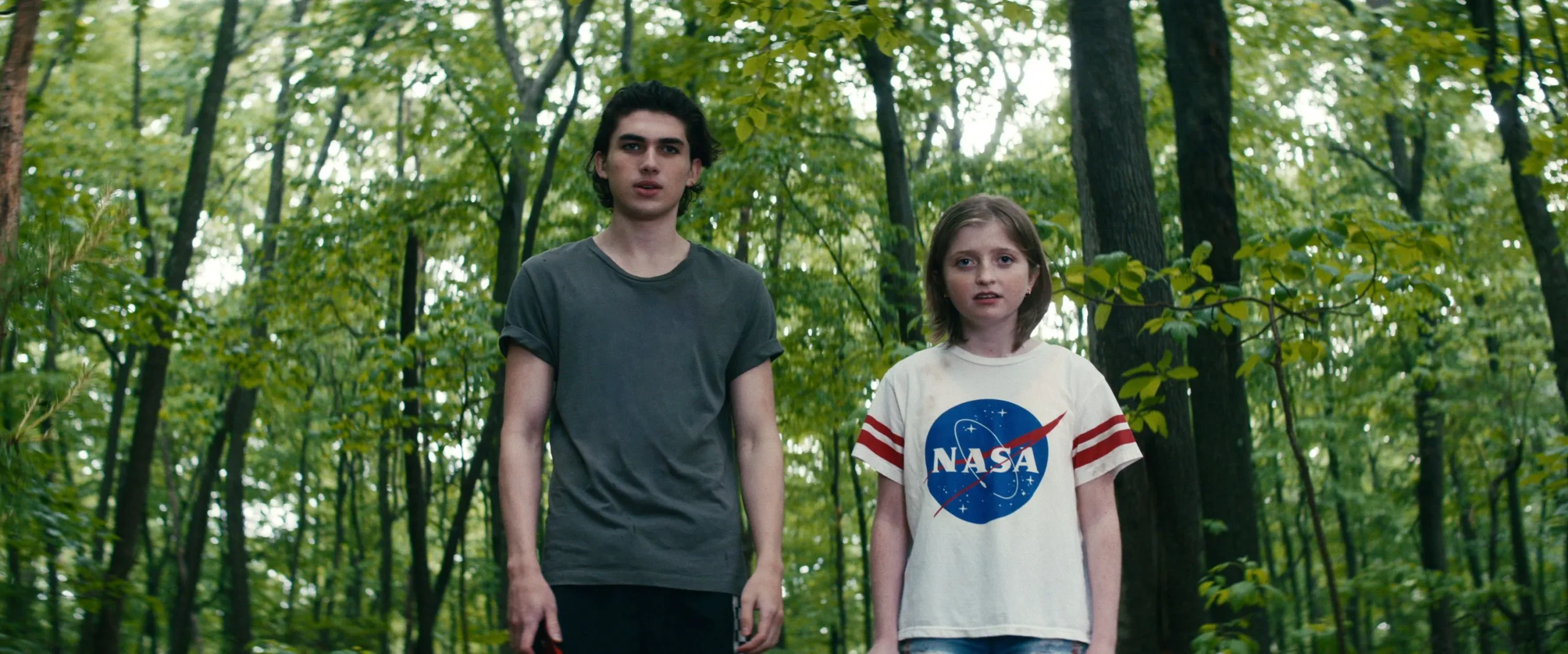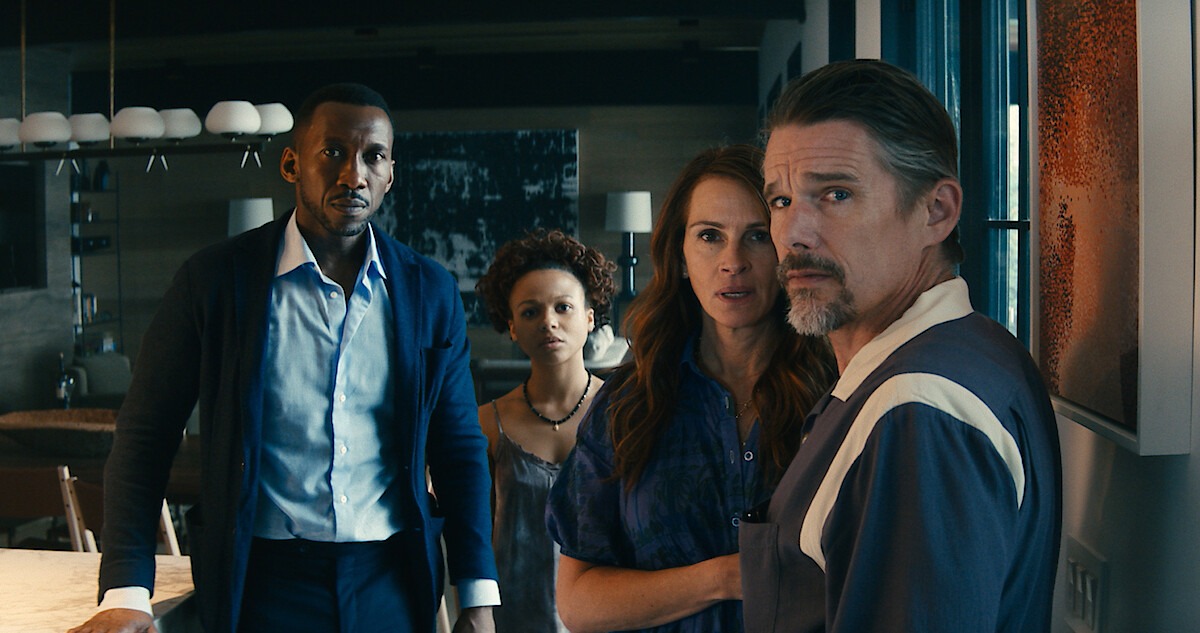Rumaan Alam, the author of Leave the World Behind, describes the novel’s conclusion as deliberately uncertain. “The key thing to observe… is that the book ends with a question mark,” he explains, reinforcing the idea that there was no singular, predetermined way the story had to conclude.
His novel serves as the foundation for Netflix’s latest apocalyptic thriller, which brings a fresh take on his original work. Sam Esmail, the director of the sci-fi adaptation, makes several alterations to the book, especially in its final moments.

Despite these differences, Alam, who is also an executive producer on the film, believes the emotional intent of his novel remains intact. He sees the changes as staying true to the core themes, even if the details have been adjusted.
The Revealed Chaos in Leave the World Behind
The story follows Amanda and Clay Sandford, portrayed by Julia Roberts and Ethan Hawke, as they take their children, Rose (Farrah Mackenzie) and Archie (Charlie Evans), on a peaceful beach vacation.
However, their retreat is soon interrupted when G.H. Scott (Mahershala Ali), the owner of the home they have rented, unexpectedly returns with his daughter Ruth (Myha’la), seeking refuge from an unknown catastrophe playing out in the city.
As tensions rise, both families find themselves trapped together while bizarre and unsettling events begin to take place. Strange occurrences include planes mysteriously crashing, herds of deer gathering in their backyard, and Archie’s teeth inexplicably falling out.
The uncertainty surrounding these events fuels an increasing sense of dread, forcing the characters to confront an unknown threat.
A Search for Answers and a Theory of Chaos
G.H. and Clay go on a drive to seek help from conspiracy theorist Danny (Kevin Bacon), hoping for some insight into the disaster. Though Danny eventually agrees to assist them, an intense confrontation leads G.H. to suspect that the strange events might be part of a larger, orchestrated effort to create national instability by turning people against one another.
Convinced that survival depends on seeking shelter, he insists that both families relocate to a bunker located in a neighbor’s home. However, this remains just a theory. Neither the book nor the film provides a concrete explanation for the crisis.
While Amanda and Ruth frantically search for Rose, who has wandered off, their attention is suddenly drawn to distant explosions lighting up the city skyline. The film’s closing scene reveals Rose discovering the neighbor’s bunker, where she stumbles upon a DVD of the final season of Friends.
As she presses play, the familiar tune “I’ll Be There for You” by The Rembrandts echoes over the film’s closing credits. The novel presents a slightly different version of this scene—rather than staying put, Rose leaves the bunker and gathers supplies to bring back to her family, suggesting a stronger chance of reunion.
Rumaan Alam on Uncertainty and the Film’s Interpretations
During an interview with Variety, Alam reflected on how the story’s ambiguity plays a vital role in its impact. He appreciates the film’s choice to conclude with an unexpected touch of humor, which he sees as both satisfying and thought-provoking.
Esmail’s background in both film and television subtly influences the decision to include Friends in the ending, highlighting the way media can provide comfort, even in the face of crisis. Audience reactions to this ending have been mixed, with some unsure whether to find it amusing or unsettling.
Alam enjoys this uncertainty, as it aligns with the broader theme of the unknown. “The audience isn’t sure—Is this funny? Is it frightening? Is it truly over? And that’s what makes it so compelling,” he explains.
The Question of Reunion: Does the Family Find Rose?
The novel implies that Rose intends to return to her family after collecting supplies, whereas the movie leaves this uncertain. With a timer set in place, the final shot of Amanda and Ruth shows them hearing the alarm go off—a signal that time has run out.
G.H.’s last words emphasize the need to reach the bunker, but whether they succeed remains unclear. Viewers might interpret this uncertainty differently. Some may assume that the family fails to reunite, while others could see G.H. as capable enough to find a solution.
Even Alam himself admits that he has no definite answer. Director Sam Esmail shares the same perspective, believing that leaving the conclusion open-ended allows the audience to make their interpretations.
G.H.’s Explanation: A Theory or the Truth?
The film gives G.H. an extended monologue where he lays out his beliefs about what might be happening. However, when Alam was writing the book, he never intended for one clear explanation to emerge.
Mahershala Ali’s powerful performance gives G.H.’s theory a sense of credibility, but even Alam acknowledges that his character’s explanation is just one possibility among many. During the writing process, Alam deliberately avoided confirming any single cause for the disaster.
He recalls how his editor suggested the possibility of aliens, which he had never considered but found intriguing. He appreciates how readers and viewers bring their perspectives to the story, making different assumptions based on their experiences and thought processes.
The Purpose of G.H.’s Theory in the Story
While G.H. provides one interpretation of the crisis, his views are shaped by his knowledge and background. If another character had been given the chance to speculate, they might have drawn completely different conclusions.

Alam sees this as a reflection of how people analyze art—everyone attempts to piece together meaning based on their insights and experiences. This mirrors the way real-world discussions reveal. Just as the characters debate their situation, viewers and readers engage in their conversations, trying to decode the mystery for themselves.
A Moment of Fear: When Reality Sinks in for G.H.
One of the film’s most striking scenes occurs when G.H. shares a car ride with Clay, during which he truly appears afraid for the first time. Alam believes this moment reveals a change in his understanding of the situation.
Up until then, G.H. has been offering logical explanations, but in this scene, he finally acknowledges the full weight of what they are facing. His theory revolves around the idea of an orchestrated attack designed to plunge society into disorder.
Ironically, the fear he describes is precisely what he and the others are experiencing—total uncertainty. The film never provides a definitive answer as to whether this is a cyberattack, an act of war, an environmental disaster, or a complete breakdown of social order. The lack of clarity is what makes it so terrifying.
Why Leave the World Behind Refuses to Provide Closure
A more conventional disaster movie might conclude by reuniting the main characters in the safety of the bunker, offering reassurance that everything will be okay. Alam and Esmail, however, choose a different path. The film respects its audience enough not to offer an easy resolution.
This approach extends to the dynamic between Amanda and Ruth. Even when they begin to understand each other, there is no emotional reconciliation—no embrace, no sentimental resolution. Instead, they acknowledge the truth in each other’s words but remain distant.
Alam expresses no issue with traditional disaster films that provide a satisfying ending, where a small group of survivors overcomes adversity.
However, Leave the World Behind was never meant to fit that mold. Instead, it challenges viewers by leaving them with unanswered questions, reinforcing the unsettling reality of an uncertain future.



